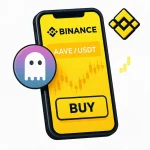If you’re looking for a transparent, fiat-backed stablecoin with strong market integrations, First Digital USD (FDUSD) is worth a look. This guide walks you through exactly how to buy FDUSD on Bitget—from creating your account to placing your first order—plus smart tips on fees, networks, and safety.
Quick action link to get started right away:
– Join Bitget with code cryptonew0 and follow the steps below. The referral benefits are automatically tied to this link.
What is FDUSD and why people use it
FDUSD (First Digital USD) is a fiat-backed stablecoin issued by First Digital Labs. It aims to maintain a 1:1 peg to the US dollar and publishes reserve attestations to support transparency. FDUSD is commonly used for:
– Hedging against crypto volatility while staying on-chain
– Moving value across exchanges and wallets quickly
– Quoting prices and settling trades in a dollar-equivalent asset
Where it lives:
– FDUSD is available on multiple networks, including Ethereum (ERC‑20) and BNB Smart Chain (BEP‑20). Always confirm the supported networks on the exchange and your wallet before any deposit or withdrawal.
At-a-glance steps
1) Create a Bitget account using this link: Sign up on Bitget with code cryptonew0
2) Secure your account with 2FA and, if available in your region, complete KYC for higher limits
3) Deposit fiat or crypto into Bitget
4) Buy FDUSD directly or trade a pair like FDUSD/USDT in Spot
5) Withdraw to your wallet if desired, choosing the correct network
Before you start
- Availability varies by region. Check Bitget’s service terms and supported jurisdictions.
- KYC may be required for certain deposit/withdrawal methods and higher limits.
- Network choice matters. FDUSD exists on more than one chain—never mix up ERC‑20 and BEP‑20 addresses.
- Fees vary by method. Card purchases, P2P, and spot trades each have different fee structures.
Create and secure your Bitget account
- Use this link to create your account: Bitget signup with referral code cryptonew0
- After signing up, immediately secure your account:
- Enable Google Authenticator or another 2FA method
- Set an anti-phishing code in your email/security panel
- Turn on withdrawal whitelist/allowlist if you plan to self-custody
Tip: Keep recovery codes in a secure, offline place. Don’t share them with anyone.
Verify your identity (KYC)
While you can often deposit crypto without KYC, completing identity verification:
– Raises deposit/withdrawal limits
– Unlocks additional fiat gateways
– Can reduce friction later when you need faster processing
Follow the on-screen prompts in your Bitget account to submit documents and complete KYC if required in your region.
Fund your account
You can fund your Bitget account in a few different ways:
1) Bank card or other fiat channels
– Go to Buy Crypto on Bitget and select your currency
– Choose your payment method (card, bank transfer, or other local options)
– If FDUSD is listed for direct purchase in your region, choose FDUSD
– Otherwise, buy a liquid asset like USDT or USDC first, then trade to FDUSD
2) P2P marketplace (where supported)
– Use P2P to buy USDT/USDC with local payment methods
– Once funds arrive in your account, you can trade into FDUSD
3) Crypto deposit from another wallet/exchange
– Go to Assets > Deposit
– Select the asset and network
– If you’re depositing FDUSD directly, choose the correct network (ERC‑20 or BEP‑20)
– Send a test transaction first to confirm the address and network
Note: Network fees and times vary. Ethereum (ERC‑20) is widely supported but can be pricier; BNB Smart Chain (BEP‑20) is often cheaper, but make sure your wallet and Bitget support it for FDUSD.
Buy FDUSD on Bitget
Once your account is funded, you can obtain FDUSD in two primary ways.
Option A: Direct fiat purchase (if available)
– Go to Buy Crypto
– Select FDUSD and the amount you want
– Confirm the quote and fee, then complete the purchase
Option B: Trade to FDUSD via Spot
– Navigate to Trade > Spot
– Search “FDUSD” in the market list
– Pick a pair like FDUSD/USDT (liquid and simple for newcomers)
– Choose your order type:
– Market Order: Fills instantly at the best available price.
– Limit Order: You set the price; it fills when the market reaches that price.
Example with a limit order:
– Suppose you hold 1,000 USDT
– You’d like FDUSD at 1.0000
– Enter price 1.0000 and amount 1,000
– Place a Buy order and wait for the fill
Pro tip: If your goal is to switch stablecoins with minimal slippage, compare a small market order versus a limit order at the midpoint. Choose the path that offers the best all-in cost once fees are accounted for.
Check your FDUSD balance
- Go to Assets > Spot to see your FDUSD balance
- If your order was a limit and hasn’t filled, you’ll see it under Open Orders
- Cancel or modify the order if you need a faster fill
Withdrawing FDUSD to your wallet
If you plan to self-custody:
– Go to Assets > Withdraw
– Choose FDUSD and pick the correct network (ERC‑20 vs BEP‑20)
– Paste your wallet address (ensure it matches the network)
– Send a small test amount first, then the rest once confirmed
Wallet tips:
– Hardware wallets offer strong security for significant amounts
– Double-check that your wallet displays the correct token on the chosen network
– Keep your seed phrase offline and never share it
Understanding fees and ways to save
- Trading fees: Maker orders sometimes cost less than taker orders. Placing limit orders can help you qualify for maker rates.
- Fiat on-ramps: Card purchases may have higher fees than bank transfers or P2P. Compare before confirming.
- Network fees: ERC‑20 withdrawals usually cost more than BEP‑20. Pick a network that’s widely supported by your receiving wallet and offers acceptable fees.
Start with the referral link for potential benefits and promos:
– Create your Bitget account with code cryptonew0
Common issues and quick fixes
- “Insufficient balance” after a purchase: Check if part of your funds is locked in open orders.
- “Network mismatch” when withdrawing: Your wallet address must match the selected network (ERC‑20 vs BEP‑20).
- Pending KYC: Limits may be temporarily reduced until verification completes.
- Cannot find FDUSD pair: Search “FDUSD” in Spot Markets. If you still can’t find it, check maintenance notices or regional availability.
- Price looks off from $1: Small deviations can occur due to liquidity, spreads, and time-of-transaction. Consider limit orders if you need precise execution.
FDUSD vs other stablecoins
- Backing and attestations: FDUSD publishes reports on reserves; compare cadence, auditor, and methodology with USDT, USDC, and others.
- Multi-chain footprint: FDUSD operates on multiple networks; verify which your wallet supports.
- Liquidity and pairs: Liquidity can vary by exchange and pair. FDUSD/USDT is often among the most active.
Safety checklist for buying FDUSD
- Use strong, unique passwords and 2FA
- Set an anti-phishing code for emails
- Use withdrawal allowlists for known wallet addresses
- Send test withdrawals first
- Keep device OS and apps updated
Frequently asked questions
Q: Is FDUSD always worth $1?
A: Stablecoins aim for a $1 peg, but market prices can fluctuate slightly. Transparency reports and robust market liquidity help maintain stability, but no asset is risk-free.
Q: Which network should I choose for FDUSD?
A: If you value broad compatibility, ERC‑20 is widely supported. If you want lower fees, BEP‑20 is often cheaper. Always ensure your wallet or destination supports the network you pick.
Q: Can I earn yield with FDUSD?
A: Exchanges sometimes offer savings or Earn products for stablecoins. These come with risks; evaluate terms, counterparty risk, and lock-up periods before participating.
Q: What’s the easiest path for a first purchase?
A: For most newcomers, depositing fiat (or buying USDT first) and then trading FDUSD/USDT via a market or limit order is straightforward.
Q: Where do I get started?
A: Use this quick link: Join Bitget with code cryptonew0 and follow the steps in this guide.
Regional and regulatory notes
- Availability, KYC requirements, and product features vary by country and region.
- Tax implications may apply to your transactions; consult a qualified professional if you’re unsure.
- This guide is for educational purposes only and does not constitute financial advice.
Handy checklist
- [ ] Create account via Bitget referral code cryptonew0
- [ ] Enable 2FA and security features
- [ ] Complete KYC if needed
- [ ] Deposit via fiat, P2P, or crypto
- [ ] Buy FDUSD directly or trade FDUSD/USDT
- [ ] Withdraw to your self-custody wallet if desired, choosing the correct network
Extra tips for smooth execution
- Compare total costs: on-ramp fee + trading fee + withdrawal fee + network fee
- Keep a small balance of native gas token on your self-custody chain (ETH for ERC‑20, BNB for BEP‑20) to pay on-chain fees
- Bookmark the official Bitget domain and be cautious of lookalike phishing sites
Start now and keep this guide open in a separate tab as you go: Open Bitget with code cryptonew0.





